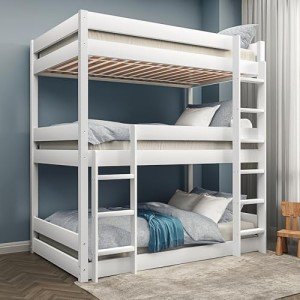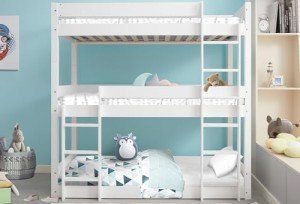bunk-bed-for-32135
bunk-bed-for-32135
You’ll Never Guess This 3 Bunk Beds’s Secrets
Exploring Three Creative Bunk Bed Designs for Modern Homes
Bunk beds have long been celebrated for their space-saving abilities and spirited styles. Whether utilized in kids’s rooms, visitor bedrooms, and even in shared home, they use a creative service to enhance space without sacrificing style. In this short article, we check out three ingenious bunk bed styles that accommodate different requirements and visual choices. We will also discuss their benefits and prospective downsides, guaranteeing that readers can make educated decisions for their homes.
1. Traditional Twin-Over-Twin Bunk Bed
Summary
The twin-over-twin bunk bed is a timeless design that has actually withstood through generations. It consists of 2 twin-sized mattresses stacked one above the other, usually including a sturdy wooden or metal frame.

Functions
- Adaptability: Ideal for shared children’s rooms or guest quarters.
- Space Efficiency: Maximizes flooring space, enabling more location for play or furniture.
- Cost-Effective: Generally more affordable than other specialized 3 Bunk Beds (that guy) bed styles.
Advantages
- Easy to put together and take apart.
- Can accommodate different mattress types.
- Frequently is available in a range of surfaces and styles.
Drawbacks
- Limited to twin-sized mattresses; not ideal for older teenagers or adults.
- May require a ladder for access, which might be a concern for younger children.
| Feature | Requirements |
|---|---|
| Measurements (L x W x H) | 78 x 42 x 60 inches |
| Weight Capacity | 250 lbs (each bed) |
| Material | Solid wood/ Metal |
| Cost Range | ₤ 150– ₤ 500 |
2. Lofted Bunk Bed with Study Area
Overview
The lofted bunk bed style takes the traditional concept an action even more by developing a living area beneath the top bunk. This structure is especially popular in children’s rooms and college dorms, as it integrates sleeping and workspace efficiently.
Features
- Usage of Space: The area beneath the top bunk can be transformed into an office, play location, or storage zone.
- Modification Options: Many designs permit additional components such as desks, shelves, or chairs to be integrated.
Advantages
- Promotes company with built-in storage alternatives.
- Encourages performance or have fun with a devoted space beneath.
- Perfect for small rooms where every square foot counts.
Drawbacks
- The height of the top bunk may position security issues, particularly for active children.
- Assembly can be more complicated due to the combination of various elements.
| Feature | Requirements |
|---|---|
| Dimensions (L x W x H) | 80 x 42 x 66 inches |
| Weight Capacity | 300 lbs (top); 200 lbs (bottom) |
| Material | Metal and laminate |
| Rate Range | ₤ 300– ₤ 700 |
3. Futon Bunk Bed
Summary
The futon bunk bed style provides a unique twist on the traditional layout by combining a top bunk with a futon couch at the bottom. This style is extremely versatile and can be utilized as a bed throughout the night and a seating location throughout the day.
Functions
- Convertible Function: The futon can be quickly transformed from a couch to a bed.
- Perfect for Small Spaces: Provides 2 functions in one piece of furniture, saving space.
Benefits
- Perfect for multi-functional spaces, particularly in studio apartments or living room.
- Appropriate for accommodating visitors, as the futon can be utilized for sleeping.
- Uses a casual aesthetic that interest a variety of tastes.
Disadvantages
- Futon mattresses tend to be thinner and less comfortable than conventional mattresses.
- The height of the top bunk might pose obstacles for older people or those with movement problems.
| Function | Specification |
|---|---|
| Dimensions (L x W x H) | 76 x 39 x 70 inches |
| Weight Capacity | 400 pounds (top); 600 lbs (futon) |
| Material | Metal frame with fabric futon |
| Cost Range | ₤ 250– ₤ 600 |
FAQ Section
1. What age is suitable for children to use bunk beds?
Usually, children aged 6 and older are considered safe for top bunk use, although this can depend upon the child’s maturity and the specific style of the bunk bed.
2. Do bunk beds require unique mattresses?
Not always, but it’s necessary to pick mattresses that are suitable with the bunk bed’s specifications. For security reasons, the mattress needs to not exceed the guardrails.
3. Can I individualize or tailor my bunk bed?
Yes! Numerous makers provide personalization choices, consisting of different surfaces, added storage, and even the capability to convert the bed designs.
4. Exist safety requirements for bunk beds?
Yes, bunk beds need to adhere to safety standards laid out by companies like the American Society for Testing and Materials (ASTM) and the Consumer Product Safety Commission (CPSC). Try to find designs that meet these safety guidelines.
5. How do I make sure the safety of a bunk bed?
Constantly check the stability of the structure, ensure the top bunk has guardrails, and emphasize safe climbing up practices. Frequently check the bed for wear and tear.
Bunk beds are a stylish and practical option for various living situations, from optimizing space in children’s rooms to accommodating guests in smaller homes. By exploring designs like the standard twin-over-twin, lofted bunk bed with a research study location, and multifunctional futon bunk beds, homeowners can choose a flexible alternative that meets their needs. Each design has unique advantages and considerations, making it vital to assess the specific context of usage before making a purchase. Whether it’s for a youngster’s room or a visitor space, there’s a bunk bed style waiting to boost performance and convenience.



